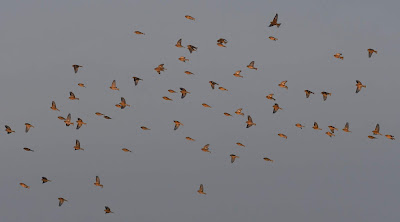It's cold outside
The last few days have been bitterly cold, with the mercury dropping to a low as minus six a few nights a go. A biting easterly wind has swept through too, and it's hard to escape the fact we're in the depths of winter now. A walk around Gate Street Barn and Wintershall may seem quiet at this time of year, but that's because most animals are less spread out as they team together.
In the area a number of winter cover crops are left standing during these testing months and they become a vital lifeline for small, seed-eating birds such as finches and buntings. As a rare source of food, large flocks group together and spend the short days feasting away. At the moment, more than 100 Linnets (known as a 'trembling) is around, a very noteworthy count for this declining species.
Other birds with them include 'charms' of Goldfinches, and smaller numbers of Brambling, Chaffinch, Redpoll, Reed Bunting and Yellowhammer. Such gatherings naturally attract predators. A Peregrine – the world’s fastest animal with stoop speeds of 243 miles per hour – has been spotted a few times recently.
Last week the cold weather from the east pushed a much rarer finch to one of the Wintershall crops. A Twite, a bird from the north and Scandinavia, spent one day tucked in among its Linnet cousins. They are very rare away from the north and east coasts during winter and this was the first in this part of Surrey for many decades.
These winter flocks are the birthplace of many traditional collective nouns for British birds. Elsewhere around Gate Street at the moment you may see a bellowing of Bullfinches, a dole of doves, paddlings of ducks, a screech of gulls, a quarrel of sparrows or a carol of Robins! And, on a crispy night, you may be fortunate to hear a parliament of owls debate with one another.
As for mammals, insects and plants, winter is time to hunker down. There is little to forage, either, though incredible as it may seem, coniferous trees can be collected. The needles of evergreen conifers are probably the easiest and most widespread thing to forage in winter and most are edible, with the exception of Yew, which is toxic. The needles of Pine, Spruce and Fir, however, can make a lovely tea, or even be used in cookies or homemade gin.
 |
| Linnets. |
In the area a number of winter cover crops are left standing during these testing months and they become a vital lifeline for small, seed-eating birds such as finches and buntings. As a rare source of food, large flocks group together and spend the short days feasting away. At the moment, more than 100 Linnets (known as a 'trembling) is around, a very noteworthy count for this declining species.
Other birds with them include 'charms' of Goldfinches, and smaller numbers of Brambling, Chaffinch, Redpoll, Reed Bunting and Yellowhammer. Such gatherings naturally attract predators. A Peregrine – the world’s fastest animal with stoop speeds of 243 miles per hour – has been spotted a few times recently.
 |
| Twite. |
Last week the cold weather from the east pushed a much rarer finch to one of the Wintershall crops. A Twite, a bird from the north and Scandinavia, spent one day tucked in among its Linnet cousins. They are very rare away from the north and east coasts during winter and this was the first in this part of Surrey for many decades.
These winter flocks are the birthplace of many traditional collective nouns for British birds. Elsewhere around Gate Street at the moment you may see a bellowing of Bullfinches, a dole of doves, paddlings of ducks, a screech of gulls, a quarrel of sparrows or a carol of Robins! And, on a crispy night, you may be fortunate to hear a parliament of owls debate with one another.
 |
| Spruce trees. |
As for mammals, insects and plants, winter is time to hunker down. There is little to forage, either, though incredible as it may seem, coniferous trees can be collected. The needles of evergreen conifers are probably the easiest and most widespread thing to forage in winter and most are edible, with the exception of Yew, which is toxic. The needles of Pine, Spruce and Fir, however, can make a lovely tea, or even be used in cookies or homemade gin.


Comments
Post a Comment